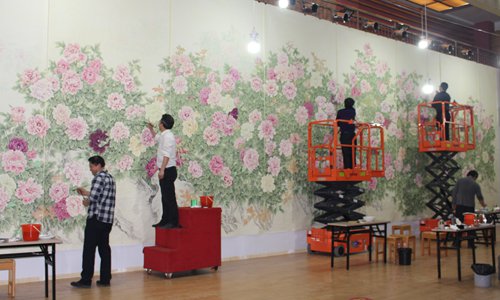
From the People's Daily app.
And this is Story in the Story.
The peony is an eternal theme for artists from Juye. Now, traditional peony paintings from this agricultural county in East China's Shandong Province have made it on to the international stage.
Paintings have been featured at the Shanghai Cooperation Organization (SCO) Qingdao Summit and first China International Import Expo (CIIE) in Shanghai.
Juye, a county with a population of 1.01 million in Heze county, has 15,000 artists and employees working in the fine art sector.
"We hope to build a 'Chinese painting town' here to boost artistic creation," said Cheng Junwei, head of the Juye Painting and Calligraphy Institute.
Peony is widely considered China's national flower, and Heze is known as the home of the peony. As a result, peonies are often the subject of paintings by artists in Juye.
Today’s Story in the Story looks at why the Juye institute wants to build a more comprehensive chain, featuring art education, creation and trade

Artists from the Juye Painting and Calligraphy Institute work on the Blossom in Prosperity for the Shanghai Cooperation Organization Qingdao Summit in East China's Shandong Province. (Photo: Courtesy of Juye Painting and Calligraphy Institute)
The giant painting Blossom in Prosperity has become a must-see spot at the Qingdao International Convention Center.
Chinese President Xi Jinping and other leaders attending the 18th SCO Summit posed for a group photo in June 2018 in front of the painting at the venue in Qingdao, a port city of Shandong.
The picture was published on the front pages of many newspapers the next day. Russian President Vladimir Putin also hosted a press conference with the painting as a backdrop.
Blossom in Prosperity, 4.2 meters wide and 15.5 meters long, features 218 blossomed peonies and was created by 10 artists at the Juye Painting and Calligraphy Institute in 77 days.
The artists experienced major challenges during the creation process and revised the artwork nine times to meet the demands of the summit organizers. "We were not at the venue during the event. But when seeing our work on TV, we were so happy and honored," said Kong Qingchen, a leading painter.
A month after the Qingdao Summit, the institute received another order to create a painting for the upcoming first CIIE.
Splendid Spring, at 15 meters long and three meters high, was completed in 79 days by eight artists.
Kong said the artists felt great pressure due to the limited amount of time they had.
"It was also very difficult to balance each artist's personal style. We had to make compromises," he said.
Hou Fuchang, another artist at the Juye institute, said people had doubts about their work during the preparation period for the events, but the Juye paintings finally stood out and became the only main background paintings for the events.
Currently, artists from the institute are creating another giant peony painting for a key ASEAN event to be held in China later this year.

A female famer works on a painting of peonies at the Luxi Painting and Calligraphy Institute. (Photo: China Daily)
In a large room of the Juye Painting and Calligraphy Institute, several painters were working in front of their huge desks. In the corner, Yu Haixia, 46, carefully colored peacock tail feathers with two brushes in her hand.
Yu is from a farming family in Taiping township, 20 minutes' drive from the institute. She only finished junior high school. Due to her passion for painting, she joined an art company in 1986 to learn painting.
She is satisfied with her 5,600 yuan ($800) salary she makes from painting. "My peers in the village are jealous of me," she said.
Currently, the county has 13 certified members of the China Artists Association and 50 in the Shandong provincial association.
Artistic creation has changed the lives of many rural residents like Yu.
In addition to the professional Juye Painting and Calligraphy Institute, the county has four townships and 50 villages that specialize in Chinese paintings, and more than 30 grassroots painting institutes.
The county sold 1.2 million paintings in 2017. The paintings are also popular overseas with buyers from 40 countries and regions including the US, France and Singapore.
Cheng, the head of Juye institute, said that the institute is seeking more financial and policy support so that they can build a more comprehensive chain.
(Produced by Nancy Yan Xu, Brian Lowe, Lance Crayon, and Paris Yelu Xu. Music by: bensound.com. Text from Global Times)


